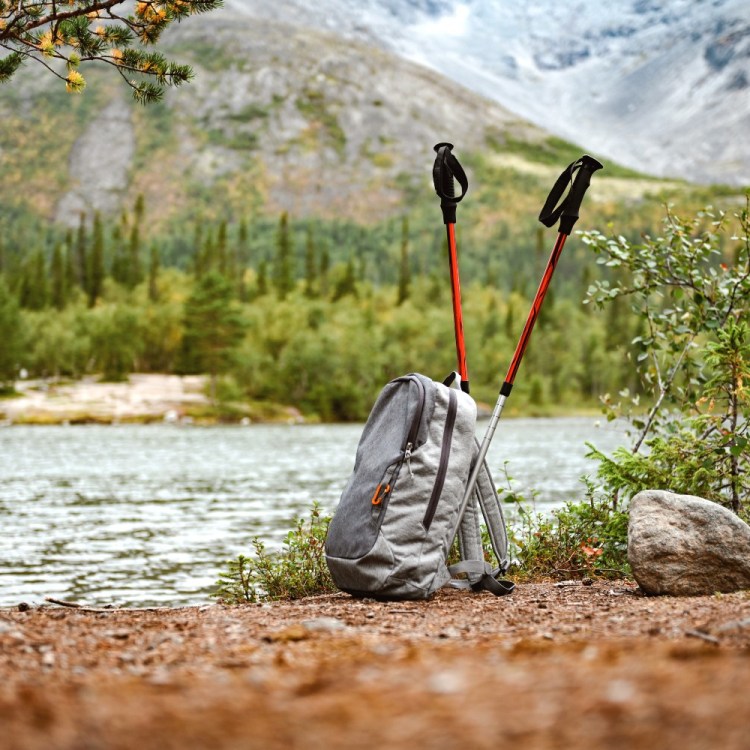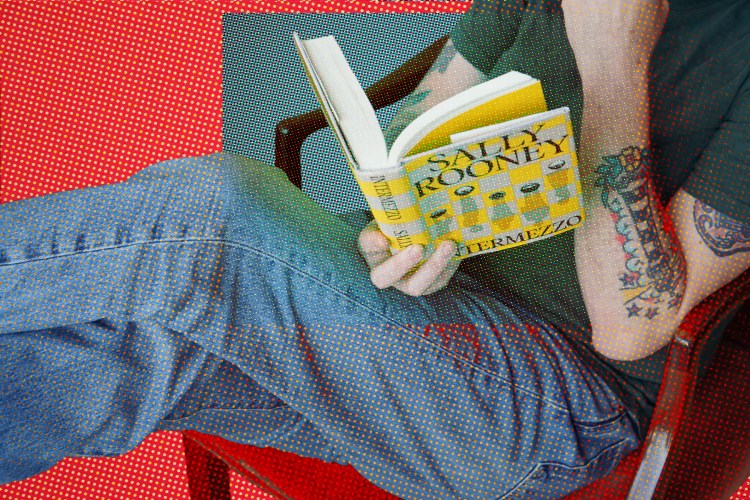
The videos started making the rounds on Instagram and TikTok last year. Men vs. reformer: burly guys on Pilates machines, moaning in agony as they pushed loop straps with their feet and balanced rings between their calves.
The bigger they are, the funnier it is. Like these bearded rugby boys. You’d think they were stomaching their third day of torture in a Middle Ages dungeon instead of exercising in an airy studio where women eagerly flock three times a week (and in some cases spend up to $300 a month) to pulse, squeeze, breathe, engage. The messaging is clear: it’s time to give Pilates respect. That shit is not easy.
Male Pilates attendance is more than a meme, though. Both Equinox and Life Time have reported huge upticks in male practitioners over the last five years. Meanwhile, Gen Z has made Pilates a pillar of its wellness routine, helping the workout place first in Class Pass’s year-end review — two years in a row. Even WHOOP has noticed a “significant rise” in logged Pilates sessions.
It’s common for middle-aged male wellness influencers to discuss the things they wish they’d started doing in their 20s, and more than once I’ve seen them nominate Pilates, talking about how its movement patterns tone muscles, ease pain and quiet the mind. Professional athletes have long been singing the exercise’s praises, too.
So, how does a beginner — especially a bearded and burly one — find his rhythm with Pilates? What should he expect from a session? What’s the difference between mat and reformer Pilates? What’s something he absolutely shouldn’t do in his first class? How long will it take to see results?
I’ve done a bit of Pilates in my day, but I’ll confess, I needed some extra help here. So I tapped an entire panel of experts: Jade Winter, CEO and co-founder of Studio Pilates International; Coco Sill, head pilates instructor at Reform Pilates LA; and Kristen Anderson, director at O2, a wellness center with Pilates studios in Dallas and Aspen.

Where Does Pilates Come From?
For starters, what even is Pilates, again? Why do I keep capitalizing that P? Well, because it’s a name, belonging to Joseph Pilates, a German writer and inventor. He developed the conditioning protocol under the somewhat dystopian term “Contrology” in the 1910s.
I vaguely knew that part. What I didn’t know was Pilates invented the concept — dozens of different moves, designed to “correct wrong postures, restore physical vitality, [and] invigorate the mind” — while living in a POW camp. He was part of a traveling circus in 1914, which got caught on the wrong side of World War I battle lines.
According to a Sports Illustrated profile by Robert Wernick published in 1962, Pilates was interned with his circus mates on the Isle of Man (yes, the tiny island in the sea between England and Ireland, which hosts the dangerous motorcycle race), in a prison called Knockaloe. For years, he watched his fellow prisoners “sink into apathy and despair.” He also watched the cats. Prison-yard cats, “lithe and springy,” somehow thriving in their own way under the same conditions.
“Why were the cats in such good shape, so bright-eyed, while the humans were growing every day paler, weaker, apathetic creatures ready to give up if they caught a cold or fell down and sprained an ankle?” Wernick wrote. “The answer came to Joe when he began carefully observing the cats and analyzing their motions for hours at a time. He saw them, when they had nothing else to do, stretching their legs out, stretching, stretching, keeping their muscles limber, alive.”
The rest is history, sort of, albeit a little-known one (even to the millions of people who practiced Pilates last year). Joe generated dozens of moves meant to train and stretch muscles throughout the body, taught these moves to his peers (who, according to the profile, at least, exited the war healthier than when it started), then moved to America to develop a machine that would further optimize those full-body movements.
When Sports Illustrated caught up with Pilates in the early 1960s, he was in his eighties — still skiing, still spearfishing, and surrounded by photos to prove it. (He was also ranting and raving about how America’s baseball players have beer bellies and hernias and can’t touch their toes.) Wernick made a fascinating and, for the era, somewhat radical observation: “Joe is more interested in muscles that will hold you up than those that will let you knock another fellow down.”
Why the Mat Matters
A Tuesday morning class at, say, O2 in Dallas is obviously far removed from Joseph Pilates’s 20th-century POW workouts on the Isle of Man. But the fundamentals haven’t changed all that much. The movement patterns — precise, whole-body, floor-based — have endured for over a century, and mat work still sits at the core of it all.
“It’s a little bit of a modern take to view the reformer classes as more challenging,” Kristen Anderson says. “Joseph Pilates created the reformer to help clients gain the strength to perform the classical mat work.”
What does that classical work look like? It’s a series of moves orbiting the practice’s six core principles: concentration, control, centering, precision, breath and flow. “Mat classes are focused on using body weight to create challenge,” Anderson explains. Sometimes those classes will employ equipment like the Pilates ball, the magic circle, resistance bands or light weights. (You’ve maybe also seen those popular bangles on social media.)
Still, as Pilates studios expand across America, many include reformers — that is, resistance machines that look like someone carved out the interior of a doctor’s examination table and added a bunch of strings and pulleys. Reformers use a system of springs to create resistance, and serve as a personal HQ for practitioners to get comfortable with Pilates’s dozens of moves, from the wheelbarrow to the crouching tiger.
Pilates is the Swiss army knife of training — it’s incredibly versatile and shockingly effective.
– Jade Winter, CEO of Studio Pilates International
Whether practiced on a mat or a reformer, the endgame of Pilates is not to stretch the muscles…or just work up a gentle sweat. It’s to develop muscular balance — and that’s more difficult than people (men, especially) give it credit for. “Even the most basic exercises tend to be relatively challenging if alignment is proper and the client is focused,” Anderson says, recounting a time during her instructor training when performing a lunge properly felt like the hardest exercise she’d ever done.
Winter, who co-founded Studio Pilates International with his wife Tanya, echoes Anderson’s thoughts here — and calls Pilates the “Swiss army knife of training.” He’s trained professional footballers and Olympic gold medalists, and reports that even elite athletes can walk out of a session shaking their heads, muttering something to the effect of “That was next-level.”
According to Winter, Pilates “trains muscle endurance, mobility and control in a way that builds a resilient body from the inside out…it’s not just about flexibility or core work — it’s about creating symmetry, balance and functional strength that shows up everywhere else in life.”
Which areas of everyday life? Well, in your other exercise pursuits, for one. Runners can use Pilates to improve gait efficiency and prevent overuse injuries. Lifters can hone core control and build endurance in underserved muscles. Then there are the sitters — which would describe all of us in the modern age. Winter considers Pilates “an antidote to the modern posture crisis.” And Anderson points out that Pilates can unlock the hips while mobilizing the thoracic spine, typically the stiffest section of the posterior chain.

Some Dos
Relax your shoulders
Form is paramount in any Pilates practice. And according to Coco Sill, the instructor at Reform Pilates LA, the alignment cue she emphasizes above all others is “relax your shoulders.”
“People tend to hold tension in their shoulders instead of activating their core and glutes,” she says. When performing arm movements, planks or any kind of core-driven exercise, it’s critical to “keep the shoulders out of the ears.” This doesn’t just foster better core activation during class — it has long-term life benefits, too. “Once they learn how to fully activate their core instead of overusing their shoulders, it’s life changing! I’ll even ask, ‘Do you get headaches?’ Once my clients get it correct, they stop waking up with headaches.”
Untuck your butt
Beyond “relax your shoulders,” what are some other bodily cues to know? Try this: squeeze your inner thighs, squeeze your glutes and “untuck your butt.”
“I feel like I say that about 40 times a day,” Anderson reports. “Sitting is so much a part of our culture now, it’s very common for clients to feel comfortable in a posteriorly tilted or tucked pelvic position, versus a neutral spine. When the pelvis becomes overly tucked, the hamstrings over-tighten and the glutes can’t fire correctly, causing clients to get stuck in their quads on lower-body exercises. The teacher that trained me called it ‘glute amnesia.’ People have a hard time getting the glutes to turn on at all!”
Move with intention, not momentum
Winter emphasizes that “Pilates isn’t about reps for the sake of reps.” It’s really about creating efficient movement through alignment, control and patience.
“When people finally understand that it’s about deliberate movement — where you can feel the exact muscle you’re targeting — everything changes,” he says. “That’s when results accelerate, and you go from going through the motions to training with real purpose.” This is a key point for men to grasp, in particular. “A lot of men think strength means big lifts, but true strength is control.”
Get started with three classes a week
Winter considers three classes a week for the first month an ideal “sweet spot.” You can build familiarity with all the foreign moves — at the very beginning, your stabilizers are going to be screaming — without totally overwhelming your system.
If you’re really struggling to get your footing (both figuratively and literally — foot flexion is key), Sill recommends booking a private session or two to build confidence and absorb the basics. “I always say, give yourself grace. There’s a lot to learn, and it’s a very hard workout.”
Some Don’ts
Don’t walk in with an ego
It goes without saying that if men are going to start invading Pilates studios, we’ll bring our egos with us. That can lead to overexertion — gutting through moves that require control and discernment — or, more likely, a bit of embarrassment. (Sill says the men in her classes “shake more than anyone.”)
Best to arrive humble and sponge-like, eager to focus and learn. Pilates exists on a different pole than most traditional training. It takes patience to learn the ropes, but you get to relearn your body’s ideal alignment in return.
Don’t forget to breathe
It’s so easy to hold your breath when you’re tense. But as in yoga, breath in Pilates is what binds intention and execution — it grounds you, steadies the work and helps build the kind of awareness that’s essential to the practice.
In your first few weeks of Pilates, Anderson recommends focusing on developing proprioception, or your sense of where your body is in space. “You can’t make an improvement if you don’t have awareness,” she says. It keeps you present, helps you notice postural tendencies and signals which muscles should be working, and which ones are just getting in the way.
Don’t quit over a “bad” instructor
There are a lot of Pilates studios out there, and a lot of instructors, too (usually two to five per studio). So don’t give up on the practice entirely after one bad experience.
“It’s important to seek out teachers who are well-trained and know the Pilates method — that should be foremost — but it’s also important to find a teacher that you click with,” Anderson says. “If the first person that you take a class or lessons from isn’t a good fit, don’t give up on Pilates or take it personally. Just try someone else!”
Don’t expect to be “good” at Pilates
How long does it take to see “results” from Pilates? Sill says her clients report improvements by their 10th session. Winter agrees, estimating most clients “see physical changes in about three weeks with consistent practice,” and after eight weeks they’re “moving better, lifting better and running stronger.”
That, in itself, Anderson stresses, is the point of Pilates. “Something I see beginners getting wrong is having an expectation or making an assessment that they are either ‘good’ or ‘bad’ at Pilates,” she says. “My goal has never been to be really good at Pilates. I use Pilates to keep my body strong and balanced so that I can do all the other things that I love.”

How to Practice Pilates Forever
How do I run forever? How do I lift forever? Tricky prospects, both — but either goal is made infinitely more realistic by a consistent Pilates routine, which naturally protects against overuse injuries, restores balance and builds muscular endurance for the long haul.
If Pilates can extend the lifespan of those punishing pursuits, imagine what it can do when it is the activity. “The studio where I completed my training caters mostly to clients ages 50 to 90,” Anderson says. “And it was such an inspiration to see how well those clients are moving compared to other individuals in their age group.”
As one 75-year-old shared in r/Pilates, “I can’t say Pilates will stop the effects of aging…but it will keep [your car] on the road and riding more smoothly than a poorly maintained old car. Parts will still wear out but not as fast.” She also noted Pilates’s role as a preventative measure against falls in old age: an under-discussed epidemic, costing seniors more than broken arms and hip fractures. These tumbles also shatter their confidence and sense of autonomy.
Want to know how to stick with Pilates? Simple: trust that once you get over that initial hill in those first few weeks of sessions, you likely won’t want to stop. “It’s like a foreign language at first, but once it clicks, it becomes the most addicting thing,” Sill says. She has a client who’s a dentist who saw a huge improvement with her posture thanks to Pilates, and now feels more present with patients.
“It helps you perform better in every area of your life. From getting out of a car, from sitting to standing, to playing golf or baseball,” she says. “It’s about living your life pain-free.”
Whether you’re looking to get into shape, or just get out of a funk, The Charge has got you covered. Sign up for our new wellness newsletter today.











